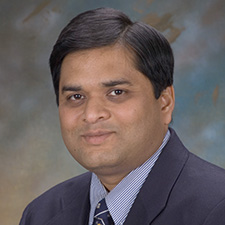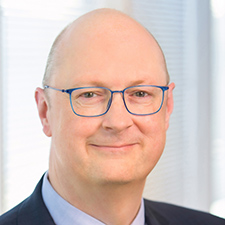Experts predict that the U.S. will be short between 17,800 and 48,000 primary care physicians by 2034. For many, those numbers may seem too abstract to fathom or the year too far away to ponder given more immediate concerns.
But one small-town doctor knows what those numbers mean to patients, because he’s starting to see it in the worry in their faces and the concern in their voices.
“I've been practicing here for 20-plus years and in the past month, I've had half a dozen inquiries from people asking: ‘Are you still planning on staying? Are you going to retire? Are you getting to that retirement age?’” said AMA member Noel Deep, MD, a past president of the Wisconsin Medical Society and an internist in Antigo, Wisconsin, a town of about 7,800 people in the northeast corner of the state.
Dr. Deep said that he and his wife, AMA member Lakshmi Deep, MD, are the only two internists in the area.
“You can see that worry” in patients’ faces, he said, “They think that, if we are gone, then they won't find any replacements at all. So that is a worry that plagues us.”
It is not an unreasonable concern for his community, where residents have already felt the impact of the physician shortage in rural America.
“We had one psychiatrist in the area who retired two years ago,” Dr. Deep said. “We have not been able to replace her.”
The nation faces a projected shortage of between 37,800 and 124,000 physicians within 12 years, according to The Complexities of Physician Supply and Demand: Projections From 2019 to 2034 (PDF), a report released by the Association of American Medical Colleges (AAMC).
When paired with U.S. Census data, the projections become particularly grim, according to another small-town physician and AMA member Sterling Ransone Jr., MD. He practices family medicine in Deltaville, Virginia, a community of about 2,000 residents.
“By 2032, the U.S. population’s going to grow by about 10%, but those of us who are age 65 or older, we’re going to grow by about 47%,” said Dr. Ransone, president of the American Academy of Family Physicians (AAFP) and a member of the AMA Scope of Practice Partnership’s advisory committee.
“By that same year, 2032, probably about one-third of active physicians are going to be over age 65, so our physicians—we’re aging as well,” he added.
Why primary care matters
Primary care’s value to a community was documented in a 2019 JAMA Internal Medicine study showing that “greater primary care physician supply was associated with lower mortality.”
“The largest decreases in cause-specific mortality associated with increased primary care physician density were for cardiovascular disease, cancer and respiratory tract disease, conditions with strong evidence of amenability to primary care management or with delayed mortality conditional on early screening through primary care,” the study says.
Despite these proven benefits, “per capita supply decreased between 2005 and 2015,” wrote the study’s authors.
This incongruity was also noted by researchers at the AAFP’s Robert Graham Center for Policy Studies in Family Medicine and Primary Care in its 2020 publication, The State of Primary Care in the United States: A Chartbook of Facts and Statistics (PDF).
“Despite renewed interest in strengthening primary care in the United States in recent years, there remains an inadequate understanding of what primary care is and does, insufficient investment in its infrastructure and growth, inadequacy in its workforce numbers and distribution, and inefficient coordination with other sectors,” the chartbook says.
The AMA House of Delegates has adopted a 25-point comprehensive policy that identified principles of and action to address the nation’s primary care labor force.
“Our patients require a sufficient, well-trained supply of primary care physicians ... to meet the nation’s current and projected demand for health care services,” says the policy, which specifies family physicians, general internists and pediatricians, and ob-gyns as primary care doctors.
Other AMA policies supporting primary care include:
- “Access to Primary Care Services.”
- “Medicaid Primary Care Payment Increases.”
- “Access to Specialty Care.”
- “Primary Care Physicians in Underserved Areas.”
Drs. Deep and Ransone will be attending the 2022 AMA Annual Meeting in Chicago this month. Dr. Deep will be part of the American College of Physicians’ delegation, and Dr. Ransone is in the AAFP’s delegation.
Excited for primary care, but then loans come due
Medical school graduates typically finish school with about $200,000 in medical student-loan debt, which is often seen as an influential factor in specialty choice. This was detailed in an AMA letter (PDF) to Education Secretary Miguel Cardona, EdD, MS, last September.
“One study indicated that 31% of medical students intended to pursue primary care in their first year of medical school, but due to debt and expected income, decided to switch to a higher-paying specialty by the end of their fourth year,” wrote AMA Executive Vice President and CEO James L. Madara, MD.
According to AMA policy, “the costs of medical education should never be a barrier to the pursuit of a career in medicine nor to the decision to practice in a given specialty.”
The AMA fights to ease young doctors’ financial burdens that contribute to physician shortages in areas underserved by limited access to health care.
This includes supporting the bipartisan “Resident Education Deferred Interest Act” that would allow borrowers to qualify for interest-free deferment on student loans while serving in a medical or dental internship or residency program. Learn about how Congress can save resident physicians $12,000 a year.
“That’s the elephant in the room,” Dr. Deep said, referring to the medical student-loan debt burdens. “Some programs will provide loan forgiveness if they work in a rural or underserved area, but you’d probably make a lot more in other specialties and be able to pay off that debt sooner.”
For his part, Dr. Ransone worries that the discussion of debt turning young doctors away from primary care could be a self-fulfilling prophesy.
“The debt issue definitely is one that's out there, but I think that, to a certain extent, it's overplayed,” Dr. Ransone said. “As a family medicine physician, I'm very well paid for my community. That said, I am paid significantly less than other specialties with similar lengths of training and expertise.
Boosting GME for primary care
Among other steps to address the primary care physician shortage, the AMA supports the “Doctors of Community Act,” aka the “DOC Act,” which would permanently authorize the Teaching Health Center Graduate Medical Education (THCGME) program.
The THCGME program covers expenses of qualified teaching health centers for the expansion, establishment and maintenance of filled positions at existing approved GME programs. Many of the teaching health centers are federally qualified health centers, rural health clinics and tribal health centers, and provide essential training for residents in family medicine, internal medicine, pediatrics, internal pediatric medicine, obstetrics and gynecology, psychiatry and geriatrics.
In academic year 2020–2021, the program trained 769 residents in 60 primary care residency programs across 25 states and, since 2011, it has supported the training of 1,148 new primary care physicians and dentists.
“Considering the current and projected physician shortage, and the increased demands that have been placed on physicians during the pandemic, additional support for this program with a proven track record of success in our urban and rural areas of the country is desperately needed,” Dr. Madara wrote in a letter (PDF) to the sponsors of the “DOC Act.”
The AMA also backs the bipartisan, bicameral “Medical Student Education Authorization Act,” which was introduced in January to authorize the Medical Student Education (MSE) Program for five years.
That program gives grants to public universities to expand or support GME in states with the most severe shortages of primary care physicians and other health professionals.
“Rural communities can have high proportions of patients from historically marginalized racial and ethnic groups, with few doctors from those backgrounds to treat them,” said AMA President Gerald E. Harmon, MD, in a news release.
“The AMA is dedicated to addressing the root causes of health inequities for the rural patient population, and this bill would help remove challenges to health equity in tribal, rural and medically underserved communities,” added Dr. Harmon, a family physician in South Carolina.
Dr. Deep said he is grateful for the AMA’s support for primary care and Dr. Harmon’s leadership.
“The AMA has been at the forefront of this,” he said. “With Dr. Harmon being a primary care physician in rural country, I think he knows exactly what we are looking at.”
Look beyond residency slots
To overcome the projected primary care shortfall, Dr. Deep said a multipronged approach is needed.
“Adding GME is not the only fix,” he said.
For one, the outdated telehealth regulations that were temporarily waived as part of the COVID-19 public health emergency and allowed physicians to be paid for telephone or virtual visits with patients in their homes, must be permanently waived, Dr. Deep said.
To learn how AMA advocacy makes it easier for physicians to expand care to their patients via telehealth and get paid fairly for their services, read the "Telehealth Impact Report" (PDF).
Dr. Deep added that primary care physicians must do more to promote their field among medical students.
Dr. Ransone, of the AAFP, agreed.
“We need to have the presence of high-quality family medicine preceptors who are enthusiastic about primary care to speak to our students and to accept students into our offices to show them what we do in rural and underserved areas, so they could see exactly what we do in the full scope of our practice,” he said.
Dr. Ransone said the variety of the services he provides keeps him from feeling burnt out, an experience borne out by the peer-reviewed literature.
“When I see things like I did today—some minor surgical procedures and dermatologic procedures—that’s what brings me joy,” he said. “It adds some excitement to my practice in the morning when I walk in not knowing exactly what’s going to walk through the door. It keeps me on my toes. It keeps me sharp.”
Dr. Ransone practices with his wife, Karen Ransone, MD, a pediatrician, which adds another dimension to his work.
“One of the greatest joys has been watching people age through my practice—people who my wife would start seeing as newborns and watching them grow to have children of their own,” he said. “I have families where we take care of four generations of people and getting to know them and be able to help take care of their problems has been a joy.”
Sharing primary care’s rewards
Dr. Deep said primary care physicians need to show medical students what is possible and to make sure that they understand that there are great rewards that go beyond financial implications.
“If you have physicians who are able to portray the happiness in your profession, in your specialty, and if I say—Hey, primary care is rewarding, look at this—the students will learn from us,” he said.
When the frustrations of paperwork or insurance company prior authorization becomes too much, Dr. Deep advises physicians to go into their offices, close the door, vent and then “go back out with a smile on your face.”
“As a physician, it is your honor and privilege to take care of vulnerable people in society—some of them at the most vulnerable times in their lives,” he said. “That's the greatest honor that you can get: Serving somebody else.
“People hold your hands, you hold their hands, and you help them through those difficult times in their lives,” Dr. Deep added. “Then they go home, and they tell their families about you. There are lots of times when the families come in and they just want to meet you. The kids come from out of town because Mom or Dad said great things about you. That's the greatest reward as a primary care physician.”





